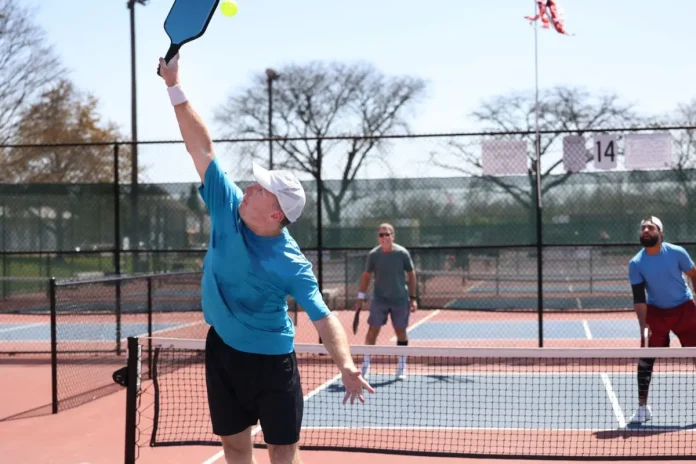Essential Injury Prevention Tips for Pickleball: As the 2025 U.S. Open Pickleball Championships begin this month in East Naples, health experts are urging players—especially those over 50—to take steps to stay injury-free. Quick moves and repetitive play can lead to serious injuries if players don’t warm up or recover properly.
Pickleball has become one of the most popular sports among older adults. But with its fast pace, even this low-impact game can put strain on the body. Diana Young, a board-certified orthopedic surgeon at the Lee Health Musculoskeletal Institute, says many players come to her office with injuries from playing pickleball.
“There are a lot of quick stops and starts in pickleball, along with lunging and twisting movements,” she notes. “When we’re younger, our bodies are more flexible, so these movements are easier and less of a strain. But as we age toward our middle years and beyond, our muscles aren’t as strong and flexible, which can affect coordination, stability, and balance.”
Common Injuries Among Older Players
Pickleball injuries affect about 19,000 players each year, and 90 percent of them are over age 50. The most common injuries include:
Achilles tendinitis or tendon ruptures
Rotator cuff problems or shoulder impingements
Tennis or golfer’s elbow
Knee sprains and meniscus tears
Wrist fractures and strains from falls
Dr. Young says many of these problems are linked to poor preparation.
“Many players rush straight into games without a proper warm-up,” Dr. Young notes. “This is especially dangerous for weekend warriors who might play intensely once a week. Your body needs time to transition from a resting state to an active one.”
How to Warm Up Safely
She recommends a 10-to-15-minute warm-up routine before each game. This includes light cardio and dynamic stretches.
“The goal is to increase blood flow and prepare your muscles for the activity,” Dr. Young says. “A proactive approach combining stretching, conditioning, and consistent activity can significantly reduce your injury risk—and may even improve your game performance.”
The American Physical Therapy Association shares the following warm-up steps:
Cardiovascular Warm-Up (5 minutes)
Jog or walk briskly around the court
Do side shuffles
Try high knees and butt kicks
Dynamic Stretching (5 to 10 minutes)
Arm circles (forward and backward)
Walking lunges with torso twists
Leg swings in all directions
Ankle rotations and calf raises
Wrist and finger stretches
Why Recovery Is Just as Important
Players should also focus on recovery the day after games. Dr. Young says gentle movement is better than total rest.
“Recovery is just as important as preparation,” Dr. Young adds. “The day after intense play should include gentle movement – what we call active recovery – rather than complete rest. This promotes blood flow to healing tissues without adding stress. Something as simple as a 20-minute walk can make a significant difference in recovery time, especially for players over 60.”
Advice for Senior Players
More than 60 percent of pickleball players are 55 or older. About one-third are over 65. For these groups, Dr. Young suggests playing it smart:
Start with short sessions and build up
Choose doubles to reduce movement
Wear shoes with good ankle support
Practice balance to avoid falls
Rest longer between games
“Many pickleball injuries I see in my practice could have been prevented with proper preparation,” notes Dr. Young. “Just 10 to 15 minutes of warm-up before play and consistent strength training can dramatically reduce your injury risk.”
The Right Paddle Can Make a Difference
Dr. Young says players with joint pain should pay attention to equipment. “Paddle selection matters tremendously, particularly for players with existing joint issues. A lighter paddle with a larger grip size can significantly reduce the strain on wrists and elbows,” she says. “Players should experiment with different paddle weights and grip sizes before investing in equipment.”
When to See a Doctor
Dr. Young says some symptoms should never be ignored. These signs mean it’s time to seek medical help:
Pain lasting more than 1–2 weeks
Swelling that doesn’t go away
Trouble moving a joint
Pain that wakes you up
A popping sound with pain and swelling
With the right approach, players can stay safe and enjoy pickleball for years to come.
News in Brief: Essential Injury Prevention Tips for Pickleball
As the U.S. Open Pickleball Championships begin, Dr. Diana Young warns players—especially seniors—about common injuries. She urges proper warm-ups, stretching, and recovery to avoid harm. She also advises using the right paddle and seeking help if pain lingers. Pickleball may be fun, but safety comes first.
ALSO READ: BMW Drives Pickleball Fever: Official Sponsor of 2025 U.S. Open Pickleball Championships

